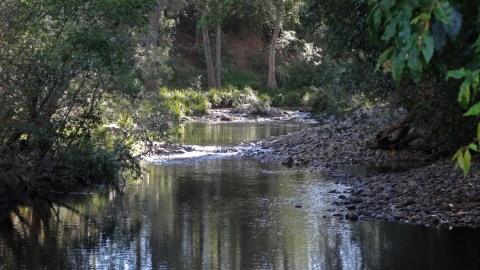- Home
- Assessments
- Bioregional Assessment Program
- Methods
- Compiling water-dependent assets
- Appendix A Simple descriptions of key tables within the asset database
Microsoft Access is used to manage information about each asset. The following tables are at the core of the structure of the asset database.
The source datasets (e.g. see Table 5) are organised into a standard format defined by the 'ElementList' table (TableA.1), as presented in Figure 4. Spatial elements from the ‘ElementList’ table are then selected and combined to create each asset, with elements from the same source dataset grouped according to attributes including group, subgroup and class (see Table 3) and name (see Table 4). Asset names are assigned according to the asset naming rules (e.g. see Table 4), and a sequential unique asset identifier (AID) is assigned to each asset that is unique across all bioregional assessment (BA) assets.
The relationship between the 'ElementList' table and the ‘AssetList’ table (TableA.3) is many-to-one with one or more elements associated with only one asset. The relationship is recorded in the ‘Element_to_asset’ table (TableA.2) using the element identifiers (ElementIDs).
The ‘Element_to_asset’ table also links directly to the ‘Decisions’ table and the ‘AssetList’ table. The ‘AssetList’ table is the basis of the water-dependent asset register. The water-dependent register is a subset of the assets that have been selected for inclusion in the bioregional assessment. They are selected on the basis explained in Section 4 .
Table A.1 'ElementList' table
|
Attributea |
Description |
|---|---|
|
ElementID |
Bioregional assessment (BA) element identifier (unique per spatial feature across all BA elements) |
|
Name |
A name given to each element either by the natural resource management (NRM) region or copied from a name field in an alternative dataset. Not all elements will have a name. |
|
Group |
The highest level of the BA classification hierarchy. Values are either ‘Economic’, ‘Ecological’ or ‘Sociocultural’ (see Table 3). |
|
SubGroup |
The second tier of the BA classification hierarchy (see Table 3). |
|
Class |
The third tier of the BA classification hierarchy (see Table 3). |
|
Depth |
Values are currently set to either ‘surface’ or ‘subsurface’. |
|
Source |
The dataset from which the element was sourced. |
|
ListDate |
The date the element was added to the element list. |
|
Geometry |
The type of spatial representation of the asset (point, line, polygon). |
|
PAE_Region |
The bioregion or subregion that the preliminary assessment extent (PAE) relates to. This element list was compiled for BA work in relation to a particular bioregion or subregion. The outer boundary of the area used to select the elements for inclusion in the assessment is spatially defined by the PAE. The PAE does not necessarily coincide with the boundary of the bioregion or subregion (e.g. an asset could be assessed in the PAE of the Namoi subregion but be physically located in the Gwydir subregion). |
|
PAE_Date |
The date of the ‘approved’ PAE which was used to select the elements to be included in the element list. |
aPunctuation and typography appear as used in the asset database.
Table A.2 'Element_to_asset' table
|
Attributea |
Description |
|---|---|
|
AID |
Bioregional assessment (BA) asset identifier (sequential and unique per asset across all assets in the Bioregional Assessment Technical Programme). |
|
AssetName |
Descriptive name given to each asset. All elements will have a name. |
|
ElementID |
BA element identifier (unique per spatial feature across all BA elements). |
|
M1 |
Flag indicating whether the asset meets ‘Test 1’ i.e. inclusion with the PAE (‘Yes/No’). |
|
DecisionNote |
Rationale for decision about the asset. |
|
MadeDate |
Date decision was made. |
aPunctuation and typography appear as used in the asset database.
Table A.3 'AssetList' table
|
Attributea |
Description |
|---|---|
|
AID |
Bioregional assessment (BA) asset identifier (sequential and unique per asset across all assets in the Bioregional Assessment Technical Programme). |
|
Name |
Meaningful, descriptive name given to each asset. |
|
Group |
The highest level of the BA classification hierarchy. Values are either ‘Economic’, ‘Ecological’ or ‘Sociocultural’ (see Table 3). |
|
SubGroup |
The second tier of the classification hierarchy (see Table 3). |
|
Class |
The third tier of the classification hierarchy (see Table 3). |
|
Depth |
Values are currently set to either ‘surface’ or ‘subsurface’. |
|
Source |
The dataset from which the element was sourced. |
|
ListDate |
The date the element was added to the element list. |
|
Geometry |
The spatial geometry type representing the asset (point, line or polygon). |
|
PAE_Region |
The bioregion or subregion that the preliminary assessment extent (PAE) relates to. This element list was compiled for BA work in relation to a particular bioregion or subregion. The outer boundary of the area used to select the elements for inclusion in the assessment is spatially defined by the PAE. The PAE does not necessarily coincide with the boundary of the bioregion or subregion (e.g. an asset could be assessed in the PAE of the Namoi subregion but be physically located in the Gwydir subregion). |
|
PAE_Date |
The date of the approved PAE that was used to select the elements to be included in the element list. |
|
AssetArea |
Calculated area of the asset. |
aPunctuation and typography appear as used in the asset database.

METHODOLOGY FINALISATION DATE
- 1 Background
- 2 Compiling the asset database
- 3 Determining and applying the preliminary assessment extent
- 4 Assessing water dependence of assets
- Appendix A Simple descriptions of key tables within the asset database
- Appendix B Identifying economic assets
- Citation
- Contributors to the Technical Programme
- About this submethodology
